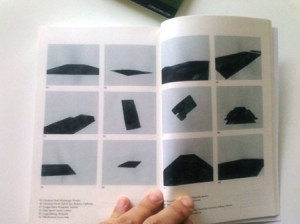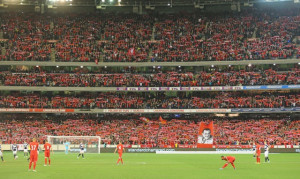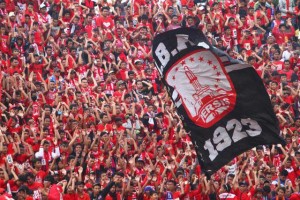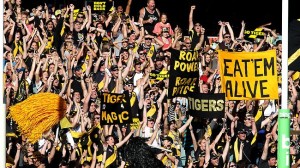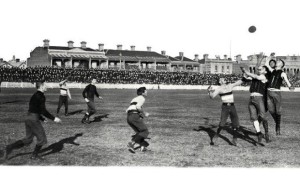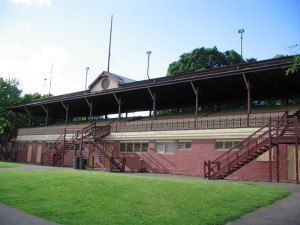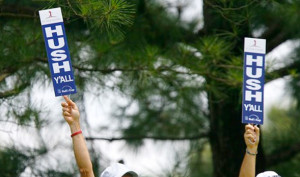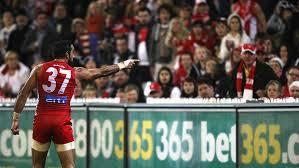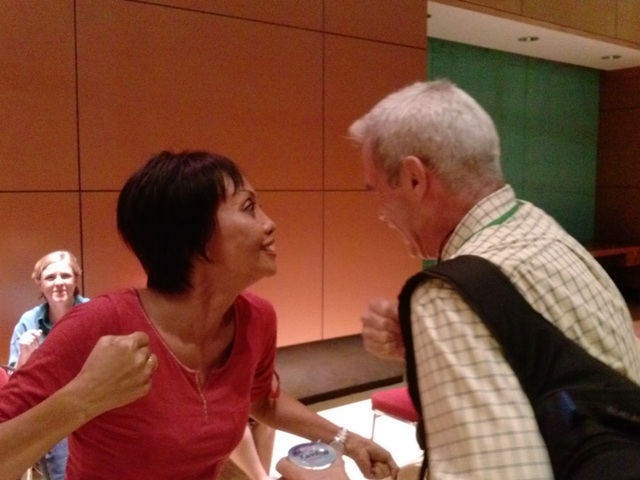I met Rupert at a concert by The Necks in January 2010 at the Corner Hotel: spitting distance from Punt Road oval. I was talking with Tina Douglas, a Melbourne-based painter, before the show. She had brought her friend, Rupert along with her. He was agitated, talking a lot – annoyed about something. I only exchanged formalities with him. Curiously, he left before the show started. The Necks played their usual two sets: one hour-long piece, slow and improvised, followed by a shorter, probably 20minute piece after a beery interval. Mesmeric, atmospheric, hypnotic being the usual words the crop up when talking about The Necks. There’s something special about seeing their music unfold live. Something that can’t be captured by listening to it on CD or through one’s little machine.
It was only at the end of the concert, that Tina started talking about Rupert. She talked about him being obsessive and never knowing anyone so fully taken up with their own painting. She mentioned how he used to be a footballer, but, he had given up after a falling out with the coach. She didn’t mention the names ‘Collingwood’ or ‘Mick Malthouse’, but, it slowly clicked that the Rupert who had been earlier and then left also early was Rupert Betheras: a member of Collingwood’s grand final sides of the early 2000s. He was also known for his role in bringing Liam Jurrah to Melbourne: a venture that would have its own trajectory. Rupert was known as an industrious player; hard working and probably not the most ‘naturally gifted’ as they say. I remember him playing in long sleeves. I also remember that I liked something about that valiant Collingwood side that only lost by a couple of goals to the mighty Brisbane.
***
Leanne Shapton, Swimming Studies, London: Penguin Books, 2012.
Here is Leanne Shapton’s website: leanneshapton.com
I am reading Leanne Shapton’s Swimming Studies, yes I am.
Shapton is a Canadian artist and former elite swimmer, who almost made it to the Olympics. Nowadays, it seems that she is equal part author, publisher, illustrator and recreational, but regular swimmer.
Swimming Studies tells the story of her rise as a swimmer, or rather, her experiences as a competitive swimmer. For, in this book at least, she cares little for the glory of winning or setting of personal best times. Instead, she focuses on the sensations of being in water, of using her muscles, and the smells that are a part of the everyday life of a swimmer.
The book – perhaps it is most easily classifiable as a memoir – is also a tale of family and domestic life. Leanne shares her swimming with her older brother, Derek. She eventually becomes a faster swimmer than him, for she has, according to her coaches a natural affinity with the water. She asks if it bothered him and he replies to say, no, ‘it meant more to her’. Yet, Leanne never really betrays this sense of full emotional engagement with her competitive swimming. Although she states that, at one point, she is ‘clinically depressed’, this is not directly linked to her swimming. It’s just another temporary sensation. The reader is only left to guess that perhaps it might be.
Shapton seems to swim because she is good at it. And that it is something she has grown up doing. Swimming is a skill that she has developed through her 5am morning practices for which she depends on her mother’s endless to-ing and fro-ing from training. There seems to be much love between them; but, it is not the tenor of the book. Shapton instead recounts the smells and rhythms of her mum’s life, rather than stating open affection. Her mother becomes another part of the aesthetics and everyday life around the thing of swimming.
Swimming Studies is enhanced by the inclusion of photographs of the swimming suits Shapton has collected throughout her times as both elite and recreational swimmer. The suits are neatly photographed on a vintage cloth mannequin, and each suit is accompanied by a brief note on where it was brought and where she wore it for the first time. The suits give an indication of the the changing attitudes towards the female body: something to be covered as much as possible, to being something athletic and capable of moving fast. The suits shift from hindering mobility to enhancing it.
The shapes of pools
Shapton addresses swimming in an original manner. She remembers the textures of swimming, its smells and its sounds. Her portraits of other swimmers, her re-drawing of the shapes of pools (above) and her paintings of swimmers swimming capture something very watery about the feeling of swimming. For me, the weakness of this book is its relative absence of plot or central focus. The plot, the subject matter, the focus are somewhat diluted. It feels like reading a series of disconnected notes on the practice of swimming. So be it. Perhaps it is aimed at being a Walter Benjaminian encounter with the overly focused and directed world of competitive sport. The strength for me, of this book, are the very personal and bare insights Shapton gives regarding her ambivalence as a swimmer. The inclusion of her paintings make up for any textual weakness.
***
There is a helluva lot of action in Betheras’s paintings. His paintings are full and thick. There is no place for the eye to rest. They must be made quickly – at least in the After Collingwood (2008) series. Marking Tracks (2011) indicates a quieter, more refined style. Finally some empty spaces emerge on the canvas. A difference between Shapton and Betheras is in that Shapton makes her painting from her experience as a swimmer; what she learned as a swimmer. Betheras’s works are an indication of someone breaking away from his identity as a footballer; leaving footy, perhaps. And thus, in one image, there is a Collingwood player with its face erased. Betheras must have been an enigmatic footballer to Collingwood fans; for indeed, so few players give up the game when they can still play it. Moreover, he gave up the relative fame of being a footy player in Melbourne for the insecurity of being an artist. Shapton and Betheras that the doing and playing of sport is a productive partner in the development of an aesthetic.


